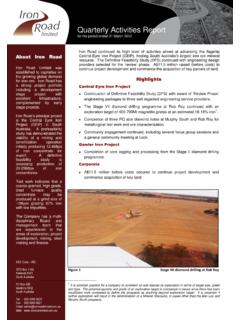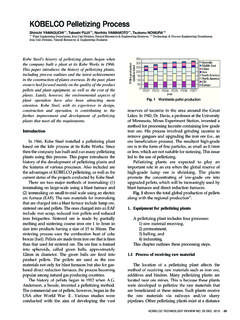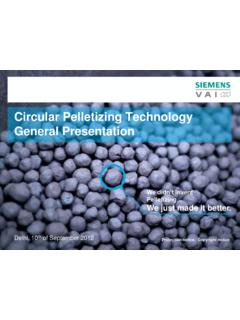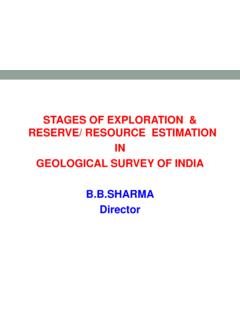Transcription of INDIAN FERRO ALLOY INDUSTRY - PRESENT …
1 INDIAN FERRO ALLOY INDUSTRY - PRESENT STATUS AND FUTURE OUTLOOK Harman Director (Technical) & Rao, Deputy General Manager (Production) FACOR Alloys Limited Shreeramnagar-535 101, e-mail: ABSTRACT Steel is the most versatile material, which has made the progress in every aspect on this earth possible. There are hundreds of varieties of steel because for each application it has to be made with specific properties to get the most optimum usage. Though the basic constituent of steel is iron, it is the proportion of other elements in it, which gives each type of steel certain specific properties. These elements are added in liquid iron in the form of FERRO alloys to get the desired composition and properties. Thus, FERRO alloys are important additives in the production of steel and FERRO Alloys INDUSTRY is vitally linked for its growth and development to that of the Steel INDUSTRY .
2 There are two major groups of alloys. 1. Bulk alloys consisting of FERRO alloys of Manganese, Chromium, Nickel and Silicon which are added in larger proportion to steels and are made by carbo thermal reduction in submerged arc electric furnaces(SAF). A schematic diagram of a submerged electric arc furnace is given in Annexure 1. 2. Noble FERRO alloys which are used in much smaller proportion in special and ALLOY steels for addition of vanadium, molybdenum, Tungsten, Zirconium, Titanium, Boron, Tantalium, Magnesium Silicon and extra Low Carbon FERRO Chrome etc. These are generally made by alumino thermic or silico thermic reduction processes. In this paper, an attempt is made to discuss on (a) INDUSTRY s profile and expansion of the bulk FERRO Alloys INDUSTRY in a phased manner. (b) Current status of the INDUSTRY with production level and extent of imports and exports of different FERRO Alloys, (c) Availability of quality inputs (d) Review of the technology adopted and (e) Challenges and opportunities in the FERRO ALLOY sector.
3 INDUSTRY S PROFILE FERRO alloys production in India is about six decades old. In India bulk FERRO alloys production through electric submerged arc furnace route made a beginning in late 1950s. After the invention by Soderberg of self- baking type electrodes, during 1920s, this became the most preferred way for making bulk FERRO alloys of Silicon, Manganese & Chromium in the world. FIRST PHASE OF THE INDUSTRY IN INDIA The initial/first phase of the INDUSTRY is marked by the installation of small capacity furnaces mostly for the production of Manganese alloys with the starting up of the first furnace at VISL, Bhadravati, total of 18 furnaces were commissioned by the mid-sixties to cater to the domestic steel INDUSTRY s requirement. The status of the INDIAN FERRO ALLOY INDUSTRY by mid-sixties is given in the table-1. 2 Table 1: Status of FERRO ALLOY INDUSTRY by the mid sixties Sl. No. Name of the Plant Furnace No.
4 Capacity In MVA Year of Start-up 1 2 3 4 5 6 7 Visveswaraya Iron & steel Co, Ltd ( VISL ) Dandeli FERRO Alloys Ltd FERRO Alloys Corporation Ltd(FACOR) Tata Iron & steel Co, Ltd (TISCO) Jeypur Sugar Co. Ltd (JEYSUCO) Universal FERRO Alloys Ltd(UFA) Khandelwal FERRO Alloys Co. Ltd. TOTAL 1 2 3 4 5 1 1 2 3 1 2 1 2 1 2 1 2 18 1950 1950 1954 1962 1962 1956 1957 1958 1960 1958 1958 1958 1959 1959 1963 1961 1962 Second phase expansion With the advent of production of stainless steel and ALLOY steels in India, of which Chromium is the most important ingredient, the chromium alloys production with totally indigenous raw materials, in view of restrictions on imports then, was innovated through research and developmental studies during sixties. FERRO Alloys Corporation Ltd., after successfully proving its production with INDIAN chrome ores, Giridhi low phos coke and non-coking coal in the 500 KVA pilot SAF at National Metallurgical Laboratory, Jamshedpur, started industrial scale production of chrome alloys in 1967.
5 [1]&[4]. First, FACOR commissioned their 12 MVA, SAF for production of High carbon FERRO chrome and Silico Chrome, then after installation of rotary kilns for pre-heating of ore fines and for calcination of lime-stone, they were fed to an 8 MVA tilting type open arc furnace for the production of Low carbon FERRO chrome. started. Thus the second phase of expansion of the INDUSTRY took place between late sixties and late seventies, when 13 (thirteen) more moderately sized furnaces were added to undertake production of Silicon and Chromium alloys. The brief details of capacity additions are given in table-2. 3 Table 2: Capacity additions in late sixties & seventies Sl. No. Name of the Plant Furnace No. Capacity In MVA Year of Start-up 1 2 3 4 5 6 7 INDIAN Metals and FERRO Alloys Ltd.(IMFA) FERRO Alloys Corporation Ltd. (FACOR) Sandur Manganese & Iron Ore Ltd,(SMIORE) Ind. Development Orissa Ltd.
6 (IDCOL) Dandeli FERRO Alloys Ltd Maharashtra Electro Smelters Ltd.(MEL) Nav Bharat FERRO Aloys Ltd. (NAVFAL) Total 1 2 4 5 1 2 1 2 2 3 1 1 2 13 1967 1974 1968 1968 1968 1977 1969 1979 1969 1969 1977 1975 1979 Third phase of expansion: The third phase of expansion in the country was prompted by product diversification, availability of advanced technology and encouragement from Government by way of incentives for setting up 100% export oriented plants, to earn valuable foreign exchange. FERRO Alloys Corporation Ltd., again for the first time in the country have pursued a strategy to utilize the disseminated ores, run of mine ore rejects and waste dumps containing on an average about 20% Cr203 in their Boula Mining lease. They sponsored beneficiation studies on these in Regional Research Laboratory, Bhubaneswar, and with the process flow-sheet developed on these studies, they set up a pilot plant for chrome ore beneficiation at their plant in Andhra Pradesh and achieved excellent results by up-gradation of such ore rejects and fines to concentrates containing more than 40% Cr203 with Cr/Fe ratio about 2 and SiO2 4 - 6%.
7 The development work was also carried out to mix these concentrates along with naturally occurring ore fines to form into briquettes which have the required crushing strength for being fed to the smelting furnaces.[2][4]. The feasibility for production of charge chrome (Cr 55-60%) using low grade lumpy chrome ores along with these briquettes was established and proved to an Expert Committee appointed by the Ministry of Steel in April 1979, in one of their sub-merged arc furnaces at Shreeramnagar. About 500 tonnes of charge chrome was produced and exported to consumers abroad. Their acceptance of this charge chrome as per international standard, enabled FACOR to obtain the industrial licence to set up the 45 MVA SAF to produce Charge Chrome and it was with their own technology. That the first 100% Export Oriented Unit for production of 50,000 TPA of charge chrome in India.
8 [3]. Thus, the era of charge chrome production began in 1983. Subsequently, two more export oriented units for FERRO chrome/charge chrome with similar capacity were installed but with foreign technical collaboration. One with Outokumpo and other with Elkem A/s, during 1980s. 13 more furnaces were started with the already developed technology of briquetting to adopt to the prevailing raw material conditions. The details of capacity additions during eighties are given in table-3. 4 Table-3: Capacity additions during eighties Sl. No. Name of the Plant Furnace No. Capacity In MVA Year of Start-up 1 2 3 4 5 6 7 8 9 10 11 Sandur Manganese & Iron Ore Ltd.(SMIORE) Maharastra Electro Smelters Ltd.(MEL) FERRO Alloys Corporation Ltd.(FACOR )Garividi INDIAN Metal & FERRO Alloys Ltd.(IMFA) Navbharat FERRO Alloys Ltd.(NABFAL) VBC FERRO Alloys Ltd FERRO Alloys Corporation Ltd. (CCP) (FACOR) OMC Alloys Ltd.
9 (OMCAL) Ispat Alloys Ltd.(IAL) INDIAN Charge Chrome Ltd Universal FERRO Allied Chemicals Ltd. (UNIFERRO)(LC FeMn) Total 3 2 6 3 3 1 1 1 1 1 3 4 5 13 1980 1981 1981 1983 1983 1984 1984 1986 1986 1989 1987 1989 1989 Fourth phase of expansion M/s. Electro kemish A/S of Norway who supplied most of the SAFs to India, on the basis of their pilot scale studies in a 2000 KVA furnace had expressed that there will be about 10% reduction in specific power while smelting in larger size furnaces compared to small size furnaces. But it is surprisingly not found to be correct in India! Smelting power and other usage norms reported by producers in small furnaces are found to be almost equal to those obtained in large furnaces! More over the smaller furnaces of capacity below have been found to have better flexibility in change over from one FERRO ALLOY to another and they can directly without agglomeration utilize ore fines without having any charge eruptions from the furnaces.
10 Use of pin vibrators to avoid bridging of charge has been found to be a good way to maintain porosity and normal descent of charge to avoid eruptions. This gave the scope for establishing many small furnaces at comparatively low initial capital cost particularly after the announcement by the Govt. of India of a liberalized de-licensing and broad banding policy, in addition to incentives like concessions in power tariff and excise duty and other tax exemptions to small scale industries in selected industrially backward areas, in some states for promoting industrialization. This resulted in mush-room growth of small scale producers of FERRO alloys during the fourth phase of expansion in India.[4]. About 69 plants with low furnace capacities ranging from 1 MVA to MVA were established. List of such small scale FERRO ALLOY units is given table-4. 5 Table- 4 : Small /Medium Scale FERRO ALLOY Units Particulars Location MVA Rating 1 2 3 4 5 6 7 8 9 10 11 12 13 14 15 16 17 18 19 20 21 22 23 24 25 26 27 28 29 30 31 32 33 34 35 36 37 38 39 40 41 42 43 44 45 46 47 48 49 50 51 Aloke FERRO Alloys Andhra FERRO Alloys Bansal FERRO Alloys Cronimet Alloys Limited Jindal Stainless Limited Andhra FERRO Alloys Ltd Deccan FERRO Alloys RVR Smelters Shree Mahalaxmi Smelters Jayalakshmi FERRO Alloys Berry Alloys Ltd Yona Smelters Abhijit FERRO tech ASV FERRO Alloys Anjaaney FERRO Alloys GSN FERRO Alloys Team FERRO Alloys RV Alloys Ltd Raghavendra FERRO Alloys Rhodium FERRO Alloys Sai Durga FERRO Alloys Manishreni FERRO Alloys Snam FERRO Alloys Impex FERRO Alloys Srihari FERRO Alloys Om Sai FERRO Alloys Deepak FERRO Alloys Haryana FERRO Alloys Hindustan FERRO Alloys Mandsour FERRO Alloys Monnet FERRO Alloys Monnet FERRO Alloys Pooja FERRO Alloys Srinivasa FERRO Alloys




